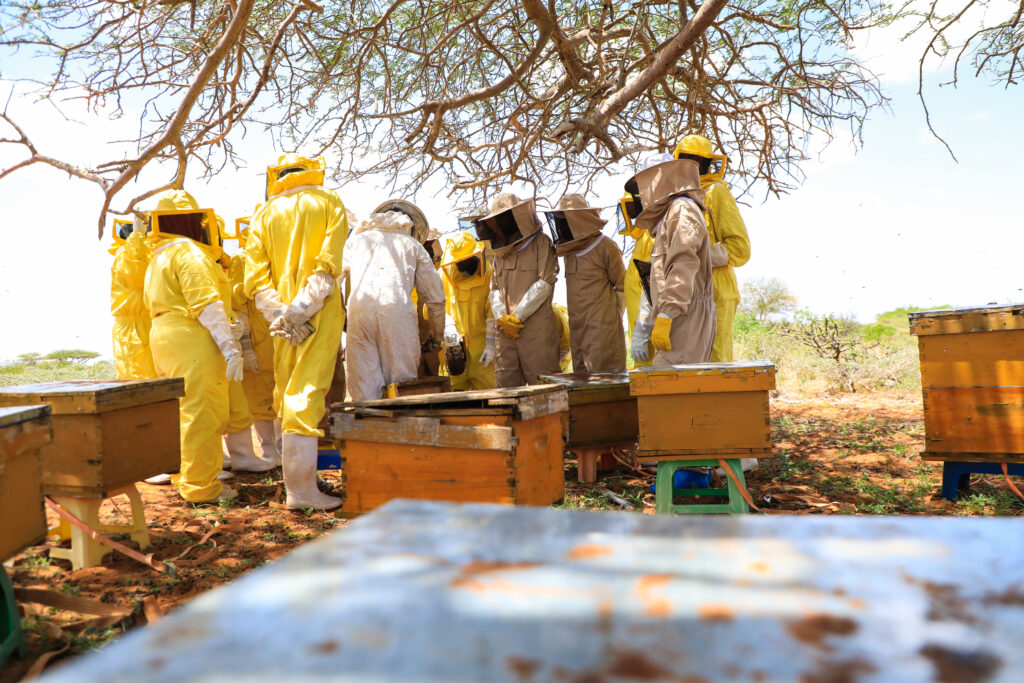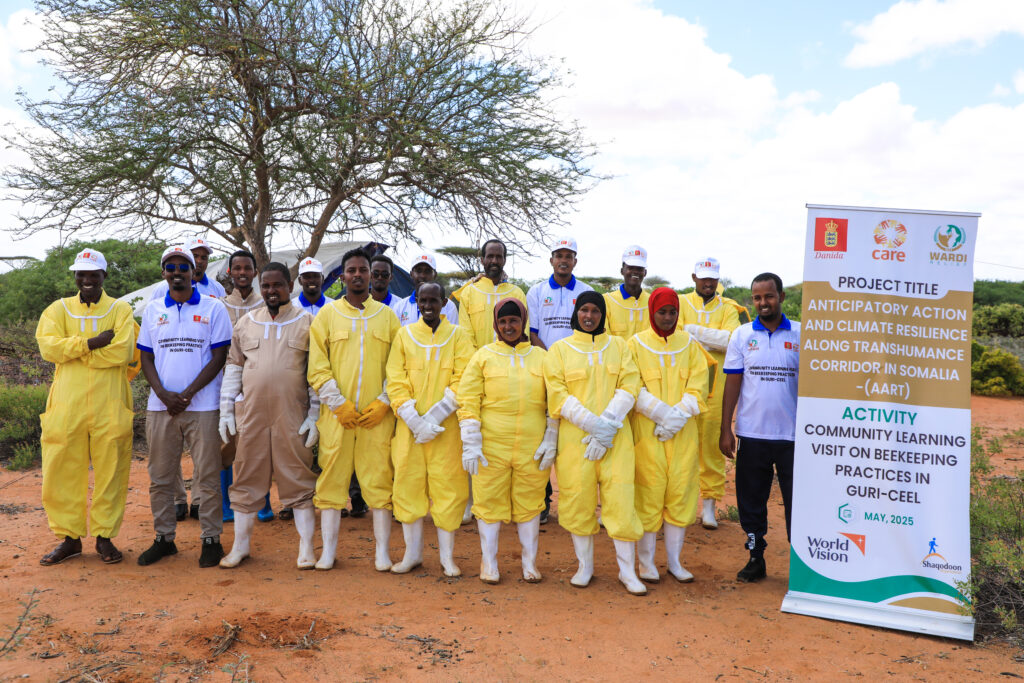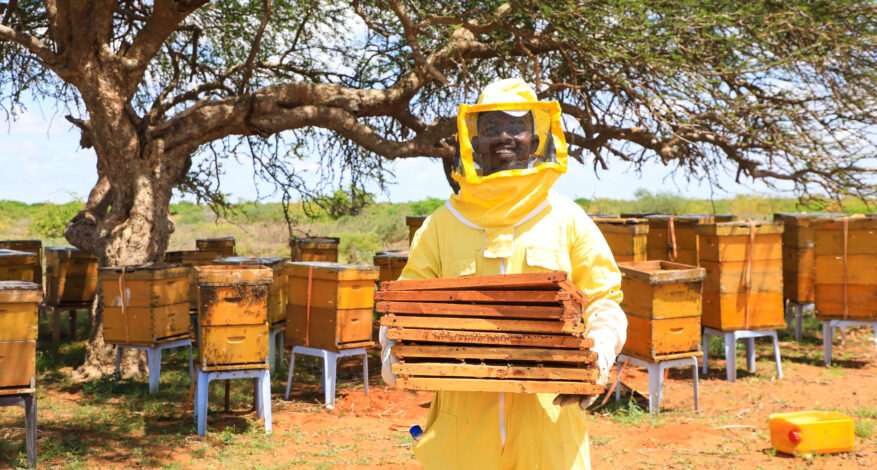Building Climate Resilience with Bees as Keepers Get 600 Hives, Training
Somalia’s pastoral tradition is centuries old. For generations, livestock were not only a source of livelihood but also a source of pride, power, and survival. Today, that tradition is buckling under the weight of a changing climate. Over the past decade, Somalia has experienced five consecutive failed rainy seasons and, consequently, the worst drought in 40 years. According to the UN, over 3.8 million livestock have perished since 2021. Rural families that were once economically stable through livestock now stare into the jaws of poverty.
Rural communities like Wanlaweyn in Lower Shabelle and Burhakaba in the Bay region are some of the worst-hit areas in Somalia. These pastoral communities that are primarily pastoralists can barely survive as pastures shrink and water sources continue to dry up.
“Our people lose their livestock to drought and famine. In most cases, they have no other source of income apart from their livestock,” explains Mohamed Abdullahi, a Senior Project Officer at WARDI. “That’s why we have developed programs like beekeeping as an alternative source of income that can weather the storm and help them sustain their lives.”
A Flight to Sustainable Beekeeping
In May 2024, WARDI took 12 traditional beekeepers from Wanlaweyn and Burhakaba for a 9-day intensive field training in Guricel, Galmudug. Most of them had never left their home districts, let alone set foot in an airport. The first-time fliers watched in awe as the plane took off from Aden Adde International Airport.
“I was amazed when I was shown my seat, but terrified when the plane took off. My heart nearly popped out of my chest. But I knew something good was waiting on the other side,” recalls Ibrahim Issack, a beekeeper from Wanlaweyn.
Guricel district is dry, dusty, and unforgiving, but the locals have turned this into a tactical advantage. Over the years, locals have embraced modern beekeeping as a climate-resilient livelihood. It is here that the visiting beekeepers saw how nature could be more of an ally than an enemy in their quest for a sustainable source of livelihood.
Led by host beekeeper and trainer Abdi Dahir, the group learned how to manage bee colonies, relocate hives, identify nectar-rich trees, and extract honey without harming the bees.
“They discovered that honey color changes with the flowers bees feed on; yellow from acacia, red from wild plum. They learned that trees are sustenance for bees just as food is for us,” Abdi explained.

From Herding Camels to Harvesting Honey
Ibrahim was a camel herder and trader for over a decade before he hung up his boots for bees, a decision he says he doesn’t regret.
“I traded in livestock, mainly camels, for 10 years before I started beekeeping,” he continued, “I can say that beekeeping is far much better than my previous job. It is more profitable and far less demanding.”
Like many pastoralists, Ibrahim watched helplessly as his herd shrank year after year as each drought left carcasses behind. Keeping camels meant long treks, high costs for water and feeds, and the constant threat of disease or sudden death of his herd.
“With bees, it’s different. You don’t need to move from region to region in search of pasture. You can stay near your home, manage your colonies, and still earn a living,” he explained.
Dahir echoes this sentiment, noting how beekeeping empowers communities to stay rooted. “Livestock keeping requires constant migration, and in today’s ever-changing climate, that’s becoming more difficult. With bees, your income depends on how well you care for them, not how far you can move. Bees are better than camels. You can harvest honey up to eight times a year if you take care of your bees. This is sufficient for household income.”
The AART Project: Building Climate Resilience with Bees
The Anticipatory Action and Climate Resilience along Transhumance Corridor in Somalia (AART) project is funded by Danida in partnership with CARE and implemented by WARDI. Through the AART project, a total of 600 beehives were distributed to six groups, each comprising five beekeepers, with each group receiving 100 modern beehives, protective gear, and professional honey extraction equipment. These modern hives are mobile and durable, leading to a more efficient and sustainable practice in the two districts.
“I would use traditional wooden hives that couldn’t be moved,” said Ibrahim. “Now, with these new hives, we can manage our colonies better, extract more honey, and protect our bees. I’ve learned how to identify the right locations, relocate colonies, and even prevent diseases.”
As the team from Wanlaweyn and Burhakaba watched and listened during the demonstrations, their hosts in Guricel, seasoned in both drought and adaptation, opened their apiaries and their hearts.
“They showed us how to scout for the right plants, how to identify flowering seasons, and how to ensure bees thrive even in harsh times,” said Ibrahim.
The trained beekeepers have returned to their bee farms to share their newfound knowledge and inspire others, especially women and youth, to embrace beekeeping as a simpler, climate-resilient, and more profitable alternative to traditional livestock keeping. They have begun mentoring fellow community members, conducting small sessions, and forming local cooperatives to scale production and sales.
“I want to thank WARDI and CARE. They have not only trained and equipped our small-scale beekeeping ventures but also walked with us for the past six months. We now have the tools and the confidence to build something sustainable for our families and our communities,” added Ibrahim Issack.

For media inquiries, please contact:
Ubah M. Bulle or Musa Salah

